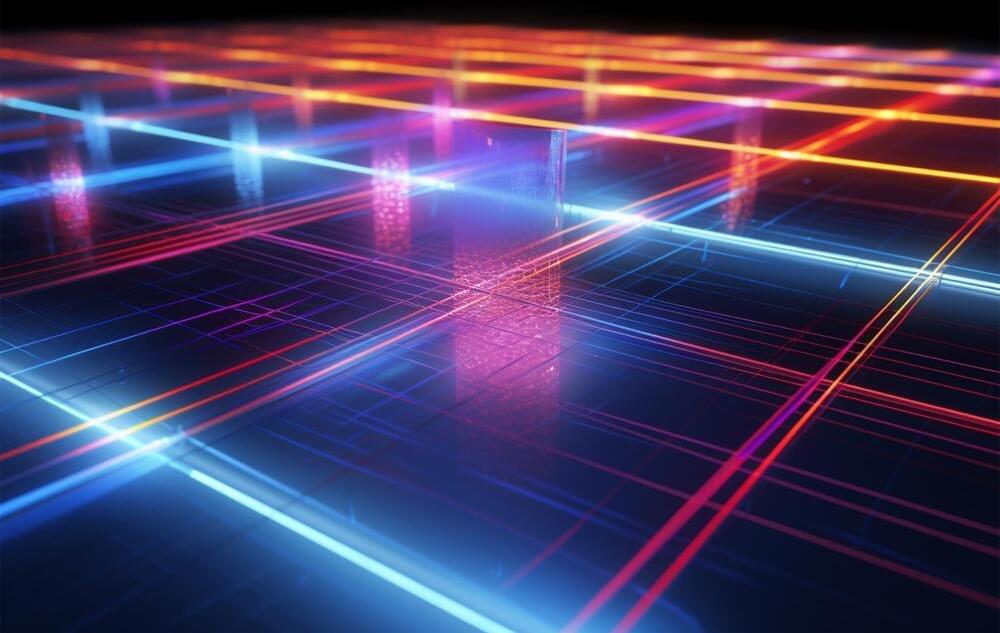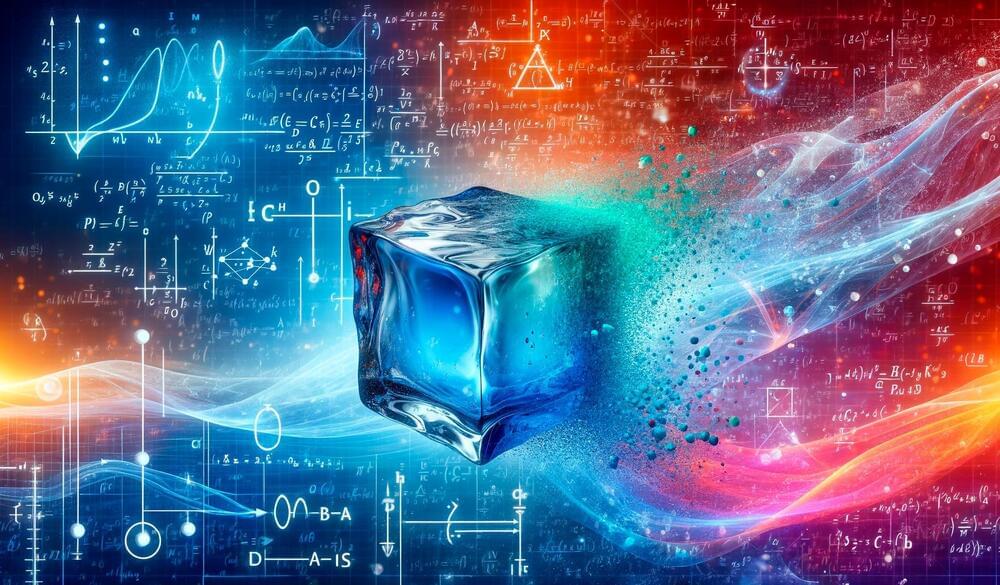Archive for the ‘physics’ category: Page 28
Apr 8, 2024
Exploring the Black Hole Population with an Open Mind
Posted by Saúl Morales Rodriguéz in categories: cosmology, physics
A new model describes the population of black hole binaries without assumptions on the shape of their distribution—a capability that could boost the discovery potential of gravitational-wave observations.
Since the first groundbreaking observation of gravitational waves from a black hole merger [1], a worldwide network of observatories–LIGO, Virgo, and KAGRA—has discovered nearly a hundred mergers involving black holes and neutron stars (Fig. 1). The nature of this population of compact objects has implications for nearly every aspect of astrophysics and cosmology. However, understanding how gravitational-wave sources fit into our astrophysical theories has proved challenging. Many of the discoveries have confirmed our expectations, but some—such as those of asymmetric black hole binaries or of unexpectedly massive black holes—defy them.
Apr 8, 2024
Revolutionizing Photonics: Researchers Achieve Unprecedented Upconversion Efficiency
Posted by Saúl Morales Rodriguéz in categories: energy, nanotechnology, physics
Scientists at the National University of Singapore (NUS) have introduced a groundbreaking concept known as “supercritical coupling,” which significantly boosts the efficiency of photon upconversion. This innovation not only overturns existing paradigms but also opens a new direction in the control of light emission.
Photon upconversion, the process of converting low-energy photons into higher-energy ones, is a crucial technique with broad applications, ranging from super-resolution imaging to advanced photonic devices. Despite considerable progress, the quest for efficient photon upconversion has faced challenges due to inherent limitations in the irradiance of lanthanide-doped nanoparticles and the critical coupling conditions of optical resonances.
The concept of “supercritical coupling” plays a pivotal role in addressing these challenges. This fundamentally new approach, proposed by a research team led by Professor LIU Xiaogang from the NUS Department of Chemistry and his collaborator, Dr Gianluigi ZITO from the National Research Council of Italy, leverages on the physics of “bound states in the continuum” (BICs). BICs are phenomena that enable light to be trapped in open structures with theoretically infinite lifetimes, surpassing the limits of critical coupling. These phenomena are different from the usual behavior of light.
Apr 7, 2024
Astronomers Confirm a New ‘Trojan’ Asteroid that Shares an Orbit with Mars
Posted by Natalie Chan in categories: chemistry, physics, space
Using observations made with the Gran Telescopio Canarias (GTC) a study led from the Instituto de Astrofísica de Canarias (IAC) and the Universidad Complutense de Madrid (UCM) has confirmed that the asteroid 2023 FW14, discovered last year, is accompanying the red planet in its journey round the sun, ahead of Mars and in the same orbit.
With this new member, the group of Trojans that accompany Mars has increased in number to 17. But it shows differences in its orbit and chemical composition which may indicate that it is a captured asteroid, of a primitive type. The results are published in Astronomy & Astrophysics.
A team from the Instituto de Astrofísica de Canarias (IAC) and the Universidad Complutense de Madrid (UCM) has observed and described for the first time the object 2023 FW14, a Trojan asteroid that shares its orbit with Mars. After Jupiter, the red planet has the largest number of known Trojans, totaling 17 with this new identification.
Apr 7, 2024
Large Hadron Collider reaches its first stable beams in 2024
Posted by Paul Battista in categories: energy, physics
On Friday 5 April, at 6.25 p.m., the LHC Engineer-in-Charge at the CERN Control Centre (CCC) announced that stable beams were back in the Large Hadron Collider, marking the official start of the 2024 physics data-taking season. The third year of LHC Run 3 promises six months of 13.6 TeV proton collisions at an even higher luminosity than before, meaning more collisions for the experiments to take data from. This will be followed by a period of lead ion collisions in October.
Before the LHC could restart, each accelerator in the CERN complex had to be prepared for another year of physics data taking. Beginning with Linac4, which welcomed its first beam two months ago, each accelerator has gone through a phase of beam commissioning in which it is gradually set up and optimised to be able to control all aspects of the beam, from its energy and intensity to its size and stability. During this phase researchers also test the accelerator’s performance and address any issues before it is used for physics. Following Linac4, which contains the source of protons for the beam, each accelerator was commissioned in turn: the Proton Synchrotron Booster, the Proton Synchrotron, the Super Proton Synchrotron, and finally the LHC from 8 March until 5 April. The whole complex is now ready for data taking.
Back to the CCC. While stable beams are the goal, the CCC engineers must first take several steps to achieve them. First, they must inject the beams into the LHC from the previous accelerators in the chain. Then begins the ramp-up process, which involves increasing the beam energy up to the nominal energy of 6.8 TeV. The next step – shown as “flat top” on LHC Page 1 – is where the energy in the beams is consistent, but they’re not quite ready yet. In order to achieve stable beams, the circulating beams must then be “squeezed” and adjusted using the LHC magnets. This involves making the beams narrower and more centred on their paths, and therefore more likely to produce a high number of collisions in the detectors. Only after the squeezing and adjustment has been completed can stable beams be declared and the experiments around the LHC begin their data taking.
Apr 6, 2024
The Melting Code Cracked: Over 100-Year-Old Physics Problem Solved
Posted by Saúl Morales Rodriguéz in categories: chemistry, physics
A professor has developed a groundbreaking theory that provides a universal method for predicting melting points, addressing a century-old challenge in physics and offering significant benefits to materials science.
A longstanding problem in physics has finally been cracked by Professor Kostya Trachenko of Queen Mary University of London’s School of Physical and Chemical Sciences. His research, published in the Physical Review E, unveils a general theory for predicting melting points, a fundamental property whose understanding has baffled scientists for over a century.
Understanding States of Matter.
Apr 6, 2024
The Big Bang’s mysteries and unsolvable “first cause” problem
Posted by Shubham Ghosh Roy in categories: cosmology, physics

But when it comes to the origin of the Universe, we don’t know what forces are at play. We actually can’t know, since to know such force (or better, such fields and their interactions) would necessitate knowledge of the initial state of the Universe. And how could we possibly glean information from such a state in some uncontroversial way? In more prosaic terms, it would mean that we could know what the Universe was like as it came into existence. This would require a god’s eye view of the initial state of the Universe, a kind of objective separation between us and the proto-Universe that is about to become the Universe we live in. It would mean we had a complete knowledge of all the physical forces in the Universe, a final theory of everything. But how could we ever know if what we call the theory of everything is a complete description of all that exists? We couldn’t, as this would assume we know all of physical reality, which is an impossibility. There could always be another force of nature, lurking in the shadows of our ignorance.
At the origin of the Universe, the very notion of cause and objectivity get entangled into a single unknowable, since we can’t possibly know the initial state of the Universe. We can, of course, construct models and test them against what we can measure of the Universe. But concordance is not a criterion for certainty. Different models may lead to the same concordance — the Universe we see — but we wouldn’t be able to distinguish between them since they come from an unknowable initial state. The first cause — the cause that must be uncaused and that unleashed all other causes — lies beyond the reach of scientific methodology as we know it. This doesn’t mean that we must invoke supernatural causes to fill the gap of our ignorance. A supernatural cause doesn’t explain in the way that scientific theories do; supernatural divine intervention is based on faith and not on data. It’s a personal choice, not a scientific one. It only helps those who believe.
Continue reading “The Big Bang’s mysteries and unsolvable ‘first cause’ problem” »
Apr 4, 2024
Unlocking exotic physics: Exploring graphene’s topological bands in super-moiré structures
Posted by Saúl Morales Rodriguéz in categories: materials, physics

In a new study, scientists from Singapore and Spain have presented a new avenue for exploring exotic physics in graphene. They focus on electronic interactions in graphene when it is sandwiched in a three-layer structure which provides a platform to exploit unique electronic band configurations.
Apr 4, 2024
First Results from DESI Make the Most Precise Measurement of Our Expanding Universe
Posted by Cecile G. Tamura in categories: cosmology, physics, robotics/AI

DESI Survey announces the most precise measurements of our expanding #universe using the BAO signal in 6.1 Million #galaxies and #Quasars from Year 1, tracing dark energy through cosmic time.
With 5,000 tiny robots in a mountaintop telescope, researchers can look 11 billion years into the past. The light from far-flung objects in space is just now reaching the Dark Energy Spectroscopic Instrument (DESI), enabling us to map our cosmos as it was in its youth and trace its growth to what we see today. Understanding how our universe has evolved is tied to how it ends, and to one of the biggest mysteries in physics: dark energy, the unknown ingredient causing our universe to expand faster and faster.
Apr 4, 2024
Largest cosmic map could shake up physics
Posted by Shubham Ghosh Roy in categories: cosmology, evolution, mathematics, physics
“Gravity pulls matter together, so that when we throw a ball in the air, the Earth’s gravity pulls it down toward the planet,” Mustapha Ishak-Boushaki, a professor of physics in the School of Natural Sciences and Mathematics (NSM) at UT Dallas, and member of the DESI collaboration, said in a statement. “But at the largest scales, the universe acts differently. It’s acting like there is something repulsive pushing the universe apart and accelerating its expansion. This is a big mystery, and we are investigating it on several fronts. Is it an unknown dark energy in the universe, or is it a modification of Albert Einstein’s theory of gravity at cosmological scales?”
DESI’s data, however, shows that the universe may have evolved in a way that isn’t quite consistent with the Lambda CDM model, indicating that the effects of dark energy on the universe may have changed since the early days of the cosmos.
“Our results show some interesting deviations from the standard model of the universe that could indicate that dark energy is evolving over time,” Ishak-Boushaki said. “The more data we collect, the better equipped we will be to determine whether this finding holds. With more data, we might identify different explanations for the result we observe or confirm it. If it persists, such a result will shed some light on what is causing cosmic acceleration and provide a huge step in understanding the evolution of our universe.”















